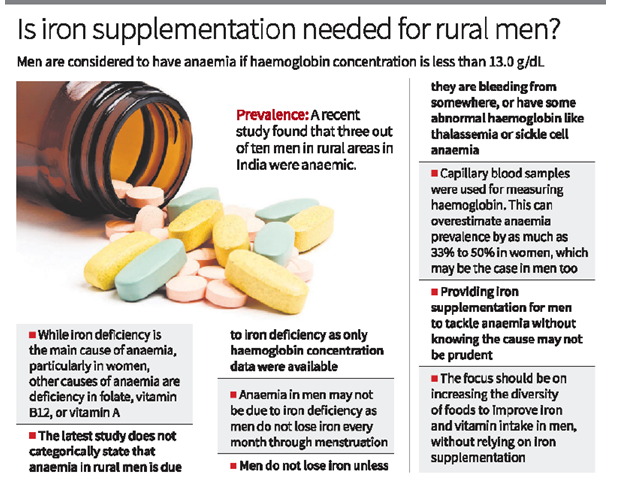- While anaemia among adolescent girls and boys, and women, particularly those of reproductive age has been studied extensively, anaemia in men has been largely ignored. In 2019, apaper published inThe Lancet Global Healthhighlighted that nearly one in four men (23.2%) in the age group 15-54 yearsin India were anaemic (mild, moderate, or severe).
- The conclusion was based on the analysis of over 1,06,000 men from the fourth round of the National Family Health Surveycarried out from January 2015 to December 2016.
- Men are considered to have anaemia if haemoglobin concentration is less than 13.0 g/dL.While iron deficiency is the main cause of anaemia, particularly in women, other causes of anaemia are deficiency in folate, vitamin B12, or vitamin A.

Prevalence of anaemia
- Now, a recent analysis of the fifth National Family Health Survey (NFHS-5) has shed light on anaemia among men living in rural areas.
- Thestudy, publishedinPLOS Global Public Health,analysed the data of over 61,000 men aged between 15-54 years.
- It found thatthree out of ten men in rural areas were anaemic; prevalence of anaemia was more in rural areas than in urban areas — one of five urban men are anaemic, while three out of every ten rural men are anaemic. Prevalence of anaemia was found to be higher (34.7%) among men who were underweight compared with men who were overweight (19.3%).
- Men who consumed alcohol and smoked had “slightly higher” occurrences of anaemia, and older men were found to be more vulnerable.
- Men in the southern States had lower anaemia prevalence (18.5%), while prevalence was highest in the eastern region (34.1%).
- Anaemia prevalence was 27.2% in the north region, 28.9% in west, 26.9% in northwest and 25% in the central region.
- Like the 2019 study, the authors of the latest paper stress that “the findings suggest the need to recognise anaemia among men as a public health issue”.
- However,the latest study does not categorically state that anaemia in rural men is due to iron deficiency.
- “We were not able to classify the type of anaemia as the NFHS-5 data had only haemoglobin concentration,” says Sumit Ram, Junior Research Fellow at the Department of Geography, Banaras Hindu University, Varanasi,and the corresponding author of the paper.
- “But previous studies have found that nearly 60% of anaemia in children and women of reproductive age is due to iron deficiency.”
- However, Dr.AnuraKurpad, Professor of Physiology at St John’s Medical College, Bengaluru is not sure ifanaemia in men is due to iron deficiency.
- “The problem is assigning a cause for anaemia among men. It is not so likely to be iron deficiency as men do not lose iron every month through menstruation.
- In fact,men do not lose iron unless they are bleeding from somewhere, or have some abnormal haemoglobin like thalassemia or sickle cell anaemia,” he says.
Iron deficiency
- Kurpad draws a parallel with anaemia in children where iron deficiency was not the main cause in many children. “The Comprehensive National Nutrition Survey data also showed that in children, only one-third of the anaemia could be solely ascribed to iron deficiency. Another one-third were mixed B vitamin deficiency, and the remaining one-third were ‘unknown causes’ (TheLancet Child Adolescent Health, July 2020),” says Dr.Kurpad.
- Despite not being sure if iron deficiency is indeed responsible for anaemia in rural men, the authors of the latest study write: “The benefits of existing programmes and policies related to anaemiaeradicationshould be extended to men as well. In addition, targeted interventions among susceptible groups of rural men are advised as a way to reduce the prevalence of anaemia.”
SOURCE: THE HINDU, THE ECONOMIC TIMES, PIB
 Chinmaya IAS Academy – Current Affairs Chinmaya IAS Academy – Current Affairs
Chinmaya IAS Academy – Current Affairs Chinmaya IAS Academy – Current Affairs